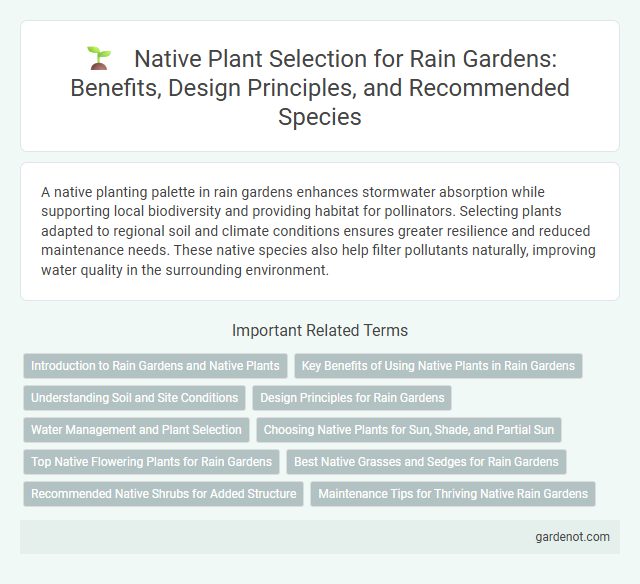A native planting palette in rain gardens enhances stormwater absorption while supporting local biodiversity and providing habitat for pollinators. Selecting plants adapted to regional soil and climate conditions ensures greater resilience and reduced maintenance needs. These native species also help filter pollutants naturally, improving water quality in the surrounding environment.
Introduction to Rain Gardens and Native Plants
Rain gardens utilize native plants such as switchgrass, black-eyed Susan, and blue flag iris to enhance stormwater absorption and support local biodiversity. These native species have deep root systems that improve soil structure and increase water infiltration, reducing runoff and preventing erosion. Incorporating a diverse native planting palette ensures a resilient rain garden that thrives in local climate conditions and provides habitat for pollinators and wildlife.
Key Benefits of Using Native Plants in Rain Gardens
Native plants in rain gardens enhance stormwater management by naturally improving soil infiltration and reducing runoff. Their deep root systems stabilize soil, prevent erosion, and support local biodiversity by providing habitat for pollinators and wildlife. Using native species promotes ecosystem resilience, requires less maintenance, and adapts well to local climate conditions, optimizing the rain garden's ecological and functional performance.
Understanding Soil and Site Conditions
Selecting a native planting palette for a rain garden requires thorough understanding of soil type, drainage patterns, and sun exposure to ensure plant health and effective water absorption. Native species adapted to local conditions promote biodiversity, reduce maintenance, and enhance pollutant filtration in stormwater runoff. Accurate soil testing and site assessment guide appropriate plant choices, optimizing rain garden performance and ecosystem benefits.
Design Principles for Rain Gardens
Native planting palettes for rain gardens prioritize deep-rooted species like Echinacea purpurea, Asclepias tuberosa, and Carex vulpinoidea, which enhance water infiltration and soil stabilization. Planting design emphasizes layering with varying heights, textures, and bloom times to maximize biodiversity and support local wildlife. Incorporating drought-tolerant and flood-resilient natives ensures the rain garden effectively manages stormwater while maintaining ecological balance.
Water Management and Plant Selection
Native planting palettes in rain gardens enhance water management by utilizing species adapted to local soil and precipitation patterns, improving infiltration and reducing runoff. Selecting deep-rooted native plants such as blue flag iris, swamp milkweed, and switchgrass supports optimal water absorption and nutrient uptake, promoting a healthy riparian ecosystem. These plants contribute to biodiversity while stabilizing soil and filtering pollutants from stormwater effectively.
Choosing Native Plants for Sun, Shade, and Partial Sun
Selecting native plants for rain gardens ensures optimal adaptation to local climate and soil conditions, enhancing stormwater absorption and biodiversity. For sunny areas, species such as purple coneflower (Echinacea purpurea) and black-eyed Susan (Rudbeckia hirta) thrive, while shade-tolerant natives like foamflower (Tiarella cordifolia) and wild ginger (Asarum canadense) perform well under tree canopies. Partial sun zones benefit from versatile plants like cardinal flower (Lobelia cardinalis) and blue flag iris (Iris versicolor), which balance moisture and light requirements effectively.
Top Native Flowering Plants for Rain Gardens
Top native flowering plants for rain gardens include Echinacea purpurea (purple coneflower), Asclepias tuberosa (butterfly weed), and Lobelia cardinalis (cardinal flower), known for their drought tolerance and pollinator attraction. These species thrive in well-drained, moist soils typical of rain gardens, enhancing water absorption and reducing runoff. Incorporating native plants like Rudbeckia hirta (black-eyed Susan) and Monarda fistulosa (wild bergamot) promotes biodiversity and supports local ecosystems.
Best Native Grasses and Sedges for Rain Gardens
Best native grasses and sedges for rain gardens include Carex vulpinoidea, Juncus effusus, and Schizachyrium scoparium, known for their deep root systems that enhance water infiltration and soil stabilization. These species are drought-tolerant, support local wildlife, and require minimal maintenance, making them ideal for sustainable rain garden design. Incorporating a diverse planting palette of native grasses and sedges optimizes stormwater management and promotes ecological resilience.
Recommended Native Shrubs for Added Structure
Recommended native shrubs for rain gardens provide essential structure while supporting local ecosystems and enhancing stormwater absorption. Species such as Inkberry (Ilex glabra), Red Twig Dogwood (Cornus sericea), and Buttonbush (Cephalanthus occidentalis) offer deep root systems that improve soil infiltration and prevent erosion. Incorporating these native shrubs promotes biodiversity and creates a resilient, visually appealing rain garden framework.
Maintenance Tips for Thriving Native Rain Gardens
Choosing a diverse native planting palette for rain gardens enhances resilience and supports local biodiversity while reducing maintenance needs. Regularly monitor soil moisture and remove invasive species to prevent competition and promote healthy plant growth. Mulching with organic materials helps retain soil moisture, suppress weeds, and improve overall garden health in native rain garden ecosystems.
Native planting palette Infographic

 gardenot.com
gardenot.com